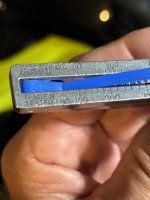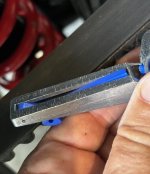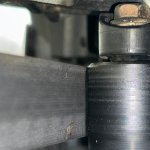AndysF3S
Active member
The manual for my 22 F3S says that 775N +/- 150N is the correct number but I don't work in N and the conversion seems to be 174 lbf with a +/- of 34 lbf. which would be 140-218 lb/f which might put your new belt in the top of the range maybe allowing for a bit of wear and stretch.
I measured mine with the Krikit and found it to be a bit inconsistent but after several readings it seemed to be reading about 200 and the belt feels tight. This was with the wheels on the ground not with the rear wheel suspended as the manual calls for so a relative reading at best and it will change with the wheel suspended.
For those who have an idler pulley (dampener) it is easily seen when looking forward from the rear muffler side ahead of the shock/spring and you can see it and touch it without disassembly. Mine is easily moved up or down with one finger pressure (not much downward spring force) and it is aligned evenly over the belt. I tried rocking the roller up and down and sideways and it is solid, but I only have about 3500 miles since new.
That brings up a new question: older (2015 as an example year) F3s had a vibration problem and the 2022 (as one example year) addressed the issue with an idler pulley. Now the 2024 F3 doesn't have the idler pulley. Does Can-Am feel the 2024 doesn't have that vibration anymore?
IMO, I would run your machine as is and see if it develops a vibration; if not, you are good to go in stock form.
I measured mine with the Krikit and found it to be a bit inconsistent but after several readings it seemed to be reading about 200 and the belt feels tight. This was with the wheels on the ground not with the rear wheel suspended as the manual calls for so a relative reading at best and it will change with the wheel suspended.
For those who have an idler pulley (dampener) it is easily seen when looking forward from the rear muffler side ahead of the shock/spring and you can see it and touch it without disassembly. Mine is easily moved up or down with one finger pressure (not much downward spring force) and it is aligned evenly over the belt. I tried rocking the roller up and down and sideways and it is solid, but I only have about 3500 miles since new.
That brings up a new question: older (2015 as an example year) F3s had a vibration problem and the 2022 (as one example year) addressed the issue with an idler pulley. Now the 2024 F3 doesn't have the idler pulley. Does Can-Am feel the 2024 doesn't have that vibration anymore?
IMO, I would run your machine as is and see if it develops a vibration; if not, you are good to go in stock form.
Last edited by a moderator:




